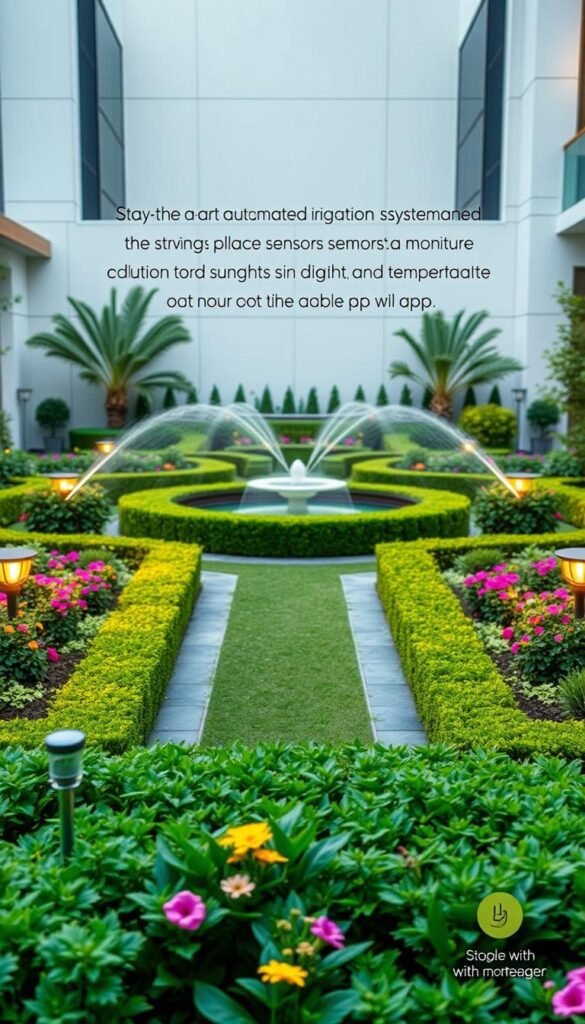Imagine stepping into a lush, thriving green space that practically takes care of itself. Modern tech-driven setups blend nature with innovation, letting you enjoy fresh blooms or homegrown veggies without the daily hassle. These systems handle watering schedules and light exposure automatically, adapting to your plants’ needs so you can focus on the joys of gardening.
Forget waking up early to water herbs or worrying about weekend trips leaving your plants parched. Self-sustaining spaces use sensors and timers to deliver precise moisture levels, while energy-efficient grow lights mimic natural sunlight. Whether you’re growing basil in a studio apartment or roses on a patio, these setups work year-round.
What makes these arrangements stand out? They’re not just functional—they’re stylish additions to any room or yard. Sleek planters and subtle tech integrations fit seamlessly into modern decor. You’ll also save resources, as automated features reduce water waste and electricity use compared to traditional methods.
Ready to simplify your green thumb journey? This guide breaks down how to create low-maintenance growing areas that flourish with minimal effort. We’ll explore setup tips, cost-saving tricks, and ways to customize layouts for your unique space. Let’s dive into the future of effortless gardening.
Introducing Your Smart Garden Adventure
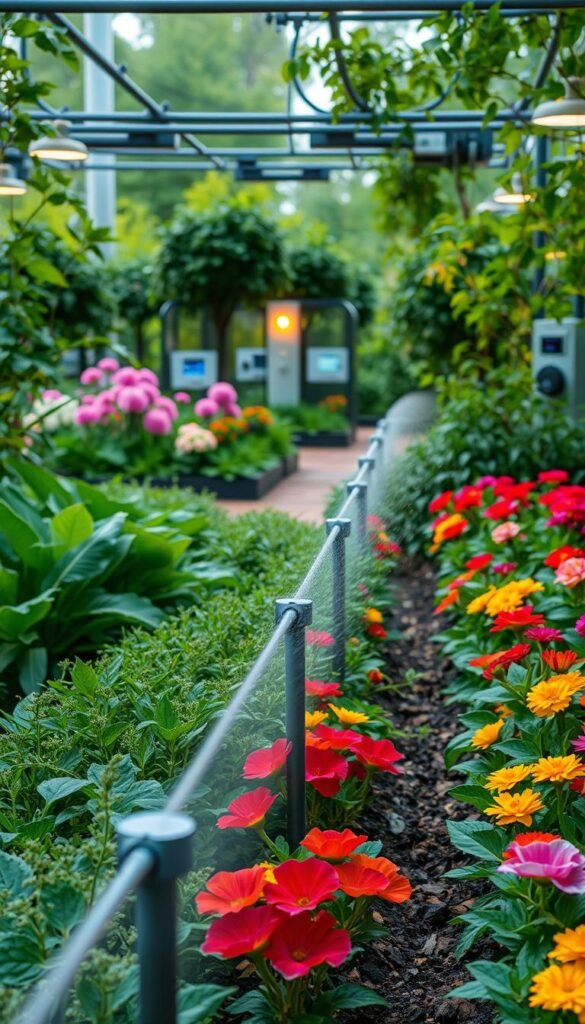
Picture a space where greenery thrives effortlessly while you focus on life’s other joys. Modern growing systems combine intuitive tech with nature’s wisdom, creating vibrant ecosystems that sustain themselves. Let’s explore how these innovations simplify plant care while boosting your well-being.
Understanding Smart Gardening Benefits
These systems do more than keep your plants hydrated. They purify air, reduce stress, and let you harvest fresh herbs year-round. Special soil blends release nutrients precisely when your greens need them, maintaining perfect acidity levels without manual testing.
Research shows caring for greenery lowers cortisol levels by 14%. Your indoor oasis becomes a calming retreat after busy days. Plus, sleek planters double as decor pieces that complement modern interiors naturally.
An Overview of Automated Systems and Technology
Built-in sensors track moisture and light levels, adjusting conditions automatically. Pair them with drip irrigation kits for precise watering that prevents root rot. LED grow lights mimic sunrise-to-sunset cycles, ensuring plants get exactly 12-16 hours of daily “sunshine.”
| Feature | Traditional Methods | Smart Solutions |
|---|---|---|
| Watering | Manual scheduling | Soil moisture sensors |
| Lighting | Natural sunlight only | Adjustable LED panels |
| Soil Care | Monthly fertilizing | pH-balancing smart soil |
| Maintenance | Daily checks | Weekly app updates |
You’ll spend 70% less time worrying about plant care. The tech handles routine tasks, freeing you to enjoy pruning fragrant basil or arranging vibrant blooms. It’s gardening made simple – no green thumb required.
Planning and Designing Your Smart Garden Space
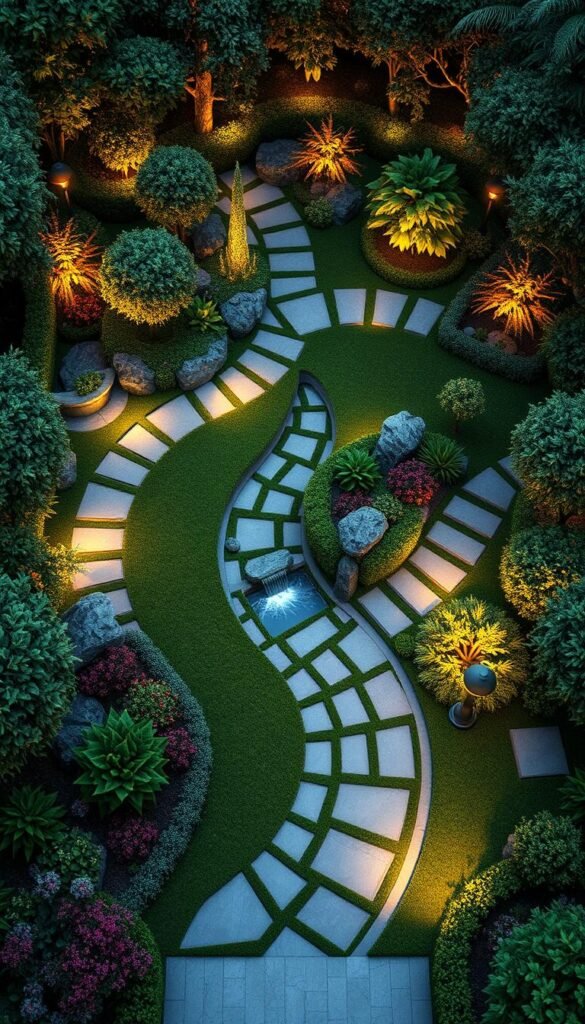
Crafting your ideal green space begins with thoughtful planning. Start by mapping sunlight patterns across your plot throughout the day. This reveals prime spots for sun-loving herbs or shade-tolerant ferns.
Assessing Your Unique Plot
Grab graph paper and sketch existing features like trees or patios. Note where shadows fall at different times. These observations help position plants where they’ll thrive naturally. Proper placement reduces water needs and boosts growth.
Modern Aesthetics Meets Function
Today’s outdoor spaces favor clean lines over clutter. Think rectangular raised beds paired with circular seating areas. Mix materials like smooth concrete planters beside rough stone pathways for visual interest.
| Traditional Approach | Contemporary Style |
|---|---|
| Curved, organic shapes | Angular geometric forms |
| Single-purpose features | Multi-functional elements |
| Random plant grouping | Strategic zone creation |
| Seasonal maintenance | Year-round structure |
Urban dwellers can maximize small areas with vertical plant walls. These living artworks add greenery without sacrificing floor space. Remember: every square foot should serve a purpose, whether growing veggies or hosting weekend barbecues.
Integrating Automated Irrigation Systems into Your Garden
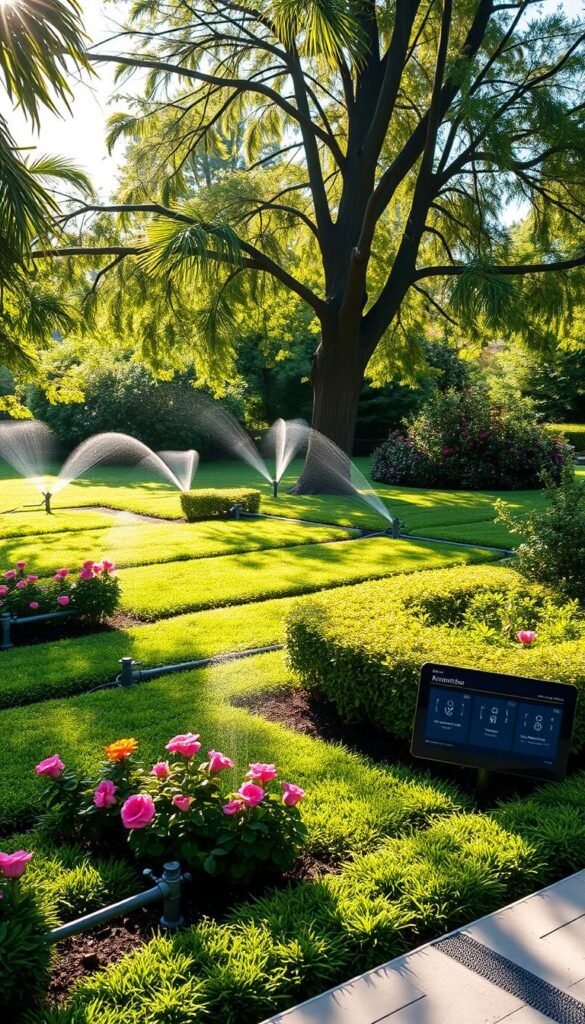
Transform how your plants drink water with precision methods that work smarter, not harder. Modern solutions deliver hydration exactly where roots need it most, eliminating guesswork while conserving resources.
Exploring Smart Irrigation Technologies
Drip systems outperform old sprinklers by targeting root zones directly. Research shows they slash water use by 60% while boosting plant health. Match emitters to your greens: 1 GPH for thirsty shrubs, 0.5 GPH for delicate veggies.
Installation becomes simple with color-coded tubing. Use 1/2-inch lines for main pathways and 1/4-inch microtubes for raised beds. Pair them with pressure regulators to maintain steady flow, preventing leaks before they start.
Adapting Watering Schedules to Weather Conditions
Your system learns local weather patterns like a seasoned farmer. Sensors pause cycles during rainstorms and increase output during heat waves. “These adjustments prevent overwatering while keeping plants stress-free,” notes a recent horticulture study.
Group plants by thirst levels using app-controlled zones. Mediterranean herbs thrive in dry beds, while leafy greens get frequent sips. Monitor everything from your phone, receiving alerts if pipes freeze or emitters clog.
You’ll watch water bills drop as plants flourish. It’s like having a personal hydration assistant working 24/7 beneath your soil.
Enhancing Plant Growth with Intelligent Lighting Solutions
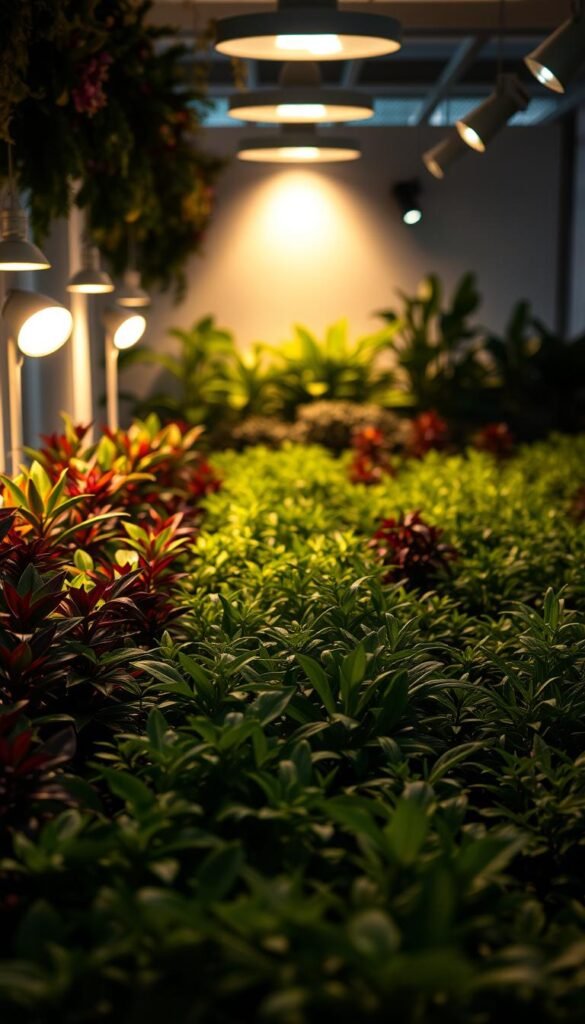
Your leafy friends deserve better than guesswork when it comes to their sunshine fix. Modern setups use science-backed illumination to mimic nature’s rhythms, giving herbs and veggies exactly what they crave. Let’s shed light on how these innovations help your greenery thrive indoors or out.
Choosing Energy-Efficient LED Options
LED panels outshine old-school bulbs by using 50% less energy while lasting 5x longer. They emit tailored spectrums – blue wavelengths for leafy growth, red tones for flowering stages. Urban growers find these perfect for small-space setups, from kitchen counter herbs to balcony tomatoes.
Delicate succulents thrive under 12-watt strips, while fruiting crops need 32-watt full-spectrum units. Look for dimmable options that adjust as seedlings mature. You’ll see faster growth without scorching tender leaves.
Automating Light Scheduling for Year-Round Growth
Timers eliminate daily switch-flipping by syncing with your plants’ biological clocks. Set 14-hour cycles for lettuce in winter or 10-hour periods for flowering orchids. Smart systems even tweak schedules during cloudy weeks, ensuring consistent exposure.
“App-connected towers automatically compensate for seasonal changes,” notes a recent horticulture report. Receive alerts when basil needs more brightness or your mint prefers shade. For compact setups, strip lights double as decor while promoting growth along shelves or walls.
With the right setup, you’ll harvest fresh flavors every month – no backyard required. It’s like having a personal sun assistant working around the clock.
Smart Garden Design Layouts: Incorporating Automated Irrigation and Lighting
Your green oasis becomes truly intelligent when all components communicate effortlessly. Start by pairing soil probes with watering devices – these sensors track moisture levels down to the root zone, triggering irrigation only when needed. This synergy prevents overwatering while keeping plants consistently hydrated.
System Integration Tips for Seamless Operation
Choose monitors that sync with your existing setup through Bluetooth or Wi-Fi. A recent study found gardens using connected devices required 40% less manual adjustments. Position probes 6 inches apart in raised beds for accurate readings, and pair them with low-cost watering solutions for budget-friendly automation.
Selecting the Right Tools and Devices
Expandable planters adapt as seedlings mature, reducing transplant stress by 65%. Look for self-watering models with built-in reservoirs. For larger spaces, robotic mowers navigate around flower beds using boundary wires, while thermal cameras on weeders distinguish crops from invaders.
Central apps unite all components through intuitive dashboards. Receive alerts when tomatoes need more light or your hydrangeas crave acidity adjustments. Top-rated systems even adjust fertilizer doses based on real-time soil data, creating a truly self-regulating ecosystem.
Maximizing Water Efficiency Through Sustainable Landscaping
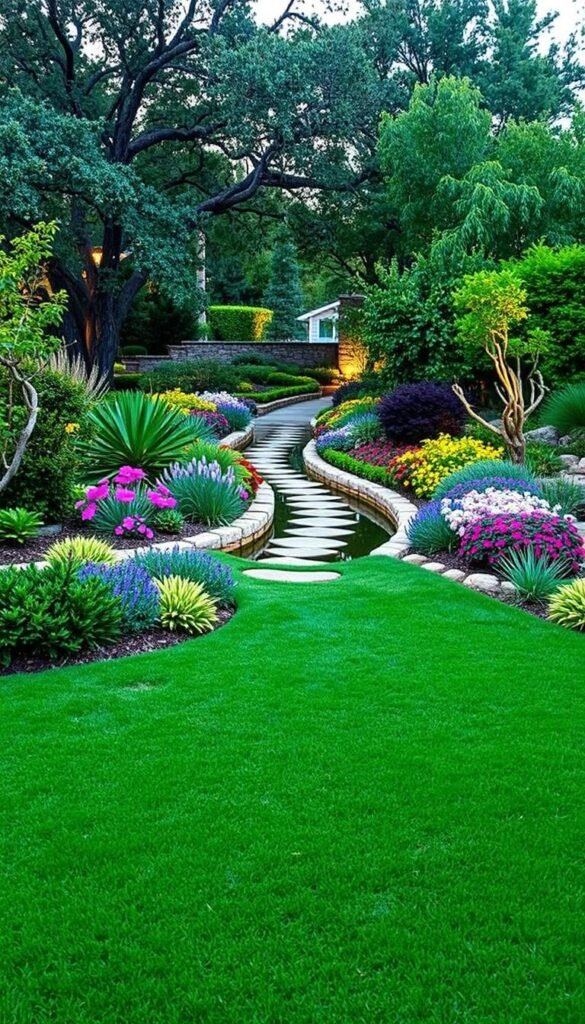
Every drop counts when nurturing a thriving landscape. Sustainable practices help your greenery flourish while slashing resource use. Start by grouping plants by their hydration needs—a method called hydrozoning. This approach ensures thirsty veggies get targeted care while drought-resistant natives thrive with minimal attention.
Implementing Drip Irrigation and Rainwater Harvesting
Drip systems deliver hydration straight to roots, using 60% less water than sprinklers. Pair them with rain barrels to collect free moisture from rooftops—a single storm can fill multiple containers. Urban growers love these solutions for space-efficient setups, combining practicality with eco-friendly benefits.
Rain gardens take conservation further. These shallow basins filled with native plants absorb 30% more runoff than lawns. They filter pollutants naturally while creating habitats for local wildlife.
Using Mulching Techniques to Conserve Moisture
A 3-inch layer of wood chips or straw acts like a protective blanket for soil. This simple step reduces evaporation by up to 50%, meaning you’ll water less frequently. Organic mulch also breaks down over time, enriching earthworms’ favorite snacks while suppressing weeds.
Combine these methods with drought-tolerant species like lavender or sedum. These hardy plants survive on rainfall alone once established, cutting maintenance while adding texture to your yard. “Proper soil prep with compost boosts water retention by 30%,” notes a recent USDA study—making every watering session count double.
Modern Garden Layouts: Blending Contemporary Flair with Functionality
Reimagine your backyard as a serene retreat where simplicity meets purpose. Today’s approach to garden design strips away clutter, letting clean lines and thoughtful arrangements shine. By blending form with function, you’ll craft spaces that refresh both eyes and spirit.
Less Is More: Curating Calm Through Minimalism
Start by choosing a restrained palette of materials—think smooth concrete paired with weathered wood. Limit plant varieties to three or four types, focusing on leaf textures rather than flower colors. This creates cohesive outdoor spaces that feel intentional, not chaotic.
Geometric patterns bring rhythm to your plot. Straight gravel paths guide footsteps, while circular seating areas invite conversation. Square raised beds contrast with round ornamental grasses, adding visual interest without overwhelming. These shapes work together like pieces in a living puzzle.
Every element should serve dual roles. A sleek water feature doubles as a bird bath, and built-in benches offer storage under their seats. Assess your space considering sunlight patterns—position dining zones where evening light lingers, and place shade-loving ferns beneath pergolas.
By merging natural elements with structured design, you’ll create an oasis that balances beauty with practicality. It’s about making every inch count while keeping maintenance low—because modern living shouldn’t mean constant yard work.

